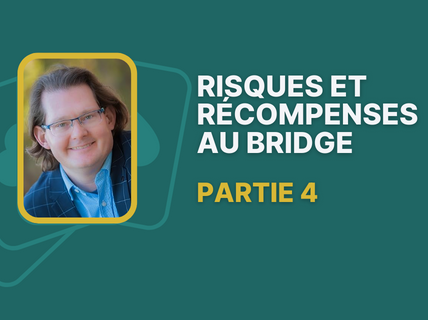



(Click here if you'd like to read Part 3 first)
So far in our series on Risk at the bridge table we have focused on the risk vs. reward thought process that we might take in the bidding:
But balancing risk and reward is also important once the bidding has ended and the card play has begun. And risk needs to be considered right off the bat, starting with the opening lead.
One of the most important questions you should ask yourself before selecting your opening lead is – Does the auction call for an active (risky) or passive (safe) opening lead?
Learning how to react to the auction and to “hear what it is telling us to do” is an important factor in getting better at opening leads. Here are a couple of examples to consider:
The opening lead is an important decision, and one that should not be wasted. Determining how aggressive to be on our opening lead is key to balancing risk and reward on defense.
Another time that we must consider how much risk to take is when we are the Declarer. One of the classic difficult Declarer play decisions is, "should we just make our contract, or should we go for an overtrick" – and risk potentially going down?
This is always a difficult decision as it is risky to go for the overtrick. Whether we do actually play for the overtrick, often has to do with, “do we need a good board” (our game is not going so well) or “do we need to avoid a bad board” (our game is going great). These are the kind of decisions that are easier to make in the middle of your session than at board 1.
Declaring a hand at Matchpoints often gives us a lot of opportunities for “top” or bottom” boards. One of the worst results we can get is -200, to go down 2 tricks vulnerable in a part-score deal. Getting this -200 “death score” is usually a disaster. Making your contract is often a good board. One of the decisions we are sometimes faced with is should we play it safe and go down 1 or should we try to make contract, and risk going down 2 tricks, for -200. How much risk should we take trying to get a good board?
Judging how much risk to take on a hand is always a challenge. Risk comes in all kinds of situations, during the bidding and the card play. You have lots of opportunities to take risk, and developing good judgement about when the reward is worth it is essential to improve as a player!
About the Author
Robert is a professional player and teacher who you’ll find all over North America (and the world). He's the founder of Adventures in Bridge and you'll find him hosting events, either virtual or in-person, almost every week of the year! Robert's also the president of the ACBL Educational Foundation where he's working to build an institution to shepherd the long term good of bridge!




StraTegies for IMP vs. MP scoring need further elaboration.
Great article! Well said.
Do you have an article on the vulnerability factors, top boards and bottom boards?
doktormustafakurt@gmail.com